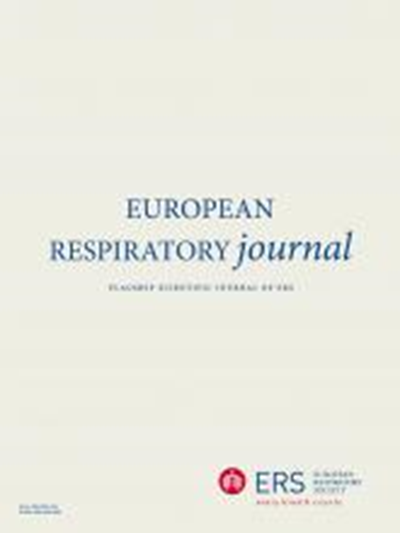Elexacaftor/tezacaftor/ivacaftor用于6岁以上F508del杂合性囊性纤维化和最小功能突变的儿童:一项为期96周的开放标签扩展研究的结果
IF 16.6
1区 医学
Q1 RESPIRATORY SYSTEM
引用次数: 0
摘要
在一项为期24周的安慰剂对照试验中,AIMSElexacaftor/tezacaftor/ivacaftor (ELX/TEZ/IVA)在6-11岁F508del杂合CFTR变体(F/MF基因型)的囊性纤维化(CF)儿童中是有效和安全的。我们对完成24周父母研究的儿童进行了为期96周的开放标签扩展研究。方法在这项3b期扩展研究中,给药基于体重和年龄,体重<30 kg和年龄<12岁的儿童接受ELX 100 mg每日一次(qd), TEZ 50 mg qd, IVA 75 mg每12小时(q12),≥30 kg或≥12岁的儿童接受ELX 200 mg qd, TEZ 100 mg qd, IVA 150 mg q12。主要终点是安全性和耐受性。次要终点和其他疗效终点包括汗液氯化物浓度、LCI2.5、ppFEV1和CFQ-R呼吸域评分相对于父母研究基线的绝对变化。结果共入组120名儿童并给药。118名儿童(98.3%)发生不良事件(ae),其中大多数为轻度(43.3%)或中度(48.3%)严重程度。最常见的ae(≥20%)为COVID-19(58.3%)、咳嗽(51.7%)、鼻咽炎(45.0%)、发热(40.0%)、头痛(37.5%)、上呼吸道感染(30.8%)、口咽部疼痛(26.7%)、鼻炎(24.2%)、腹痛(22.5%)和呕吐(20.0%)。从父母研究的安慰剂组和ELX/TEZ/IVA组过渡的儿童在第96周的平均汗液氯化物浓度(-57.3 [95% CI: -61.6, -52.9]和-57.5 [95% CI: -62.0, -53.0] mmol·L-1), LCI2…5比父母研究基线有所改善(-1.74 [95% CI: -2.09, -1.38]和-2.35 [95% CI: -2.72, -1.97]个单位),ppFEV1 (6.1 [95% CI: 2.6, 9.7]和6.9 [95% CI: 3.2, 10.5]个百分点),CFQ-R呼吸域评分(6.6 [95% CI: 2.5, 10.8]和2.6 [95% CI: -1.6, 6.8]个百分点)。结论selx /TEZ/IVA治疗总体上是安全且耐受性良好的,其安全性与父母研究和老年人群一致。在开始ELX/TEZ/IVA后,儿童的汗液氯化物浓度和肺功能得到了显著改善,并维持了96周。这些结果证明了ELX/TEZ/IVA在儿科人群中的安全性和持久有效性。(Clinical Trials.gov, NCT04545515;EudraCT, 2020-001404-42)。本文章由计算机程序翻译,如有差异,请以英文原文为准。
Elexacaftor/tezacaftor/ivacaftor in children aged ≥6 years with cystic fibrosis heterozygous for F508del and a minimal function mutation: Results from a 96-week open-label extension study.
AIMS
Elexacaftor/tezacaftor/ivacaftor (ELX/TEZ/IVA) was efficacious and safe in children aged 6-11 years with cystic fibrosis (CF) heterozygous for F508del and a minimal function CFTR variant (F/MF genotypes) in a 24-week, placebo-controlled trial. We conducted a 96-week open-label extension study for children who completed the 24-week parent study.
METHODS
In this phase 3b extension study, dosing was based on weight and age with children weighing <30 kg and aged <12 years receiving ELX 100 mg once daily (qd), TEZ 50 mg qd, and IVA 75 mg every 12 h (q12) and children ≥30 kg or ≥12 years receiving ELX 200 mg qd, TEZ 100 mg qd, and IVA 150 mg q12. Primary endpoint was safety and tolerability. Secondary and other efficacy endpoints included absolute changes from parent study baseline in sweat chloride concentration, LCI2.5, ppFEV1, and CFQ-R respiratory domain score.
RESULTS
A total of 120 children were enrolled and dosed. One hundred and eighteen children (98.3%) had adverse events (AEs), which for most were mild (43.3%) or moderate (48.3%) in severity. The most common AEs (≥20% of children) were COVID-19 (58.3%), cough (51.7%), nasopharyngitis (45.0%), pyrexia (40.0%), headache (37.5%), upper respiratory tract infection (30.8%), oropharyngeal pain (26.7%), rhinitis (24.2%), abdominal pain (22.5%), and vomiting (20.0%). Children who transitioned from the placebo and ELX/TEZ/IVA groups of the parent study had improvements from parent study baseline at Week 96 in mean sweat chloride concentration (-57.3 [95% CI: -61.6, -52.9] and -57.5 [95% CI: -62.0, -53.0] mmol·L-1), LCI2..5 (-1.74 [95% CI: -2.09, -1.38] and -2.35 [95% CI: -2.72, -1.97] units), ppFEV1 (6.1 [95% CI: 2.6, 9.7] and 6.9 [95% CI: 3.2, 10.5] percentage points), and CFQ-R respiratory domain score (6.6 [95% CI: 2.5, 10.8] and 2.6 [95% CI: -1.6, 6.8] points).
CONCLUSIONS
ELX/TEZ/IVA treatment was generally safe and well-tolerated, with a safety profile consistent with parent study and older age groups. After starting ELX/TEZ/IVA, children had robust improvements in sweat chloride concentration and lung function that were maintained through 96 weeks. These results demonstrate the safety and durable efficacy of ELX/TEZ/IVA in this pediatric population. (Clinical Trials.gov, NCT04545515; EudraCT, 2020-001404-42).
求助全文
通过发布文献求助,成功后即可免费获取论文全文。
去求助
来源期刊

European Respiratory Journal
医学-呼吸系统
CiteScore
27.50
自引率
3.30%
发文量
345
审稿时长
2-4 weeks
期刊介绍:
The European Respiratory Journal (ERJ) is the flagship journal of the European Respiratory Society. It has a current impact factor of 24.9. The journal covers various aspects of adult and paediatric respiratory medicine, including cell biology, epidemiology, immunology, oncology, pathophysiology, imaging, occupational medicine, intensive care, sleep medicine, and thoracic surgery. In addition to original research material, the ERJ publishes editorial commentaries, reviews, short research letters, and correspondence to the editor. The articles are published continuously and collected into 12 monthly issues in two volumes per year.
 求助内容:
求助内容: 应助结果提醒方式:
应助结果提醒方式:


